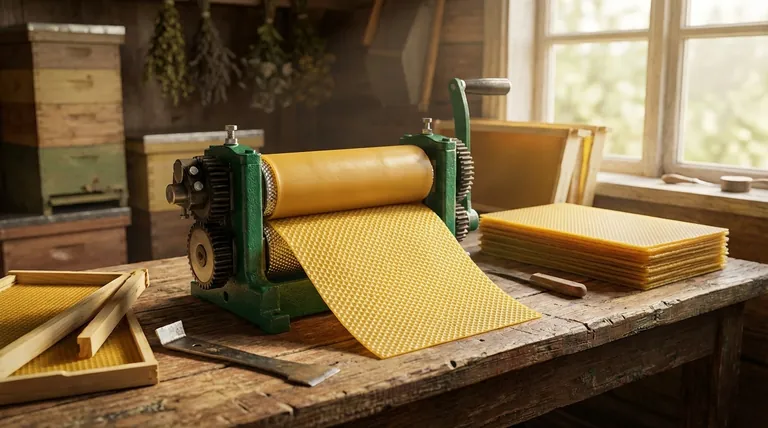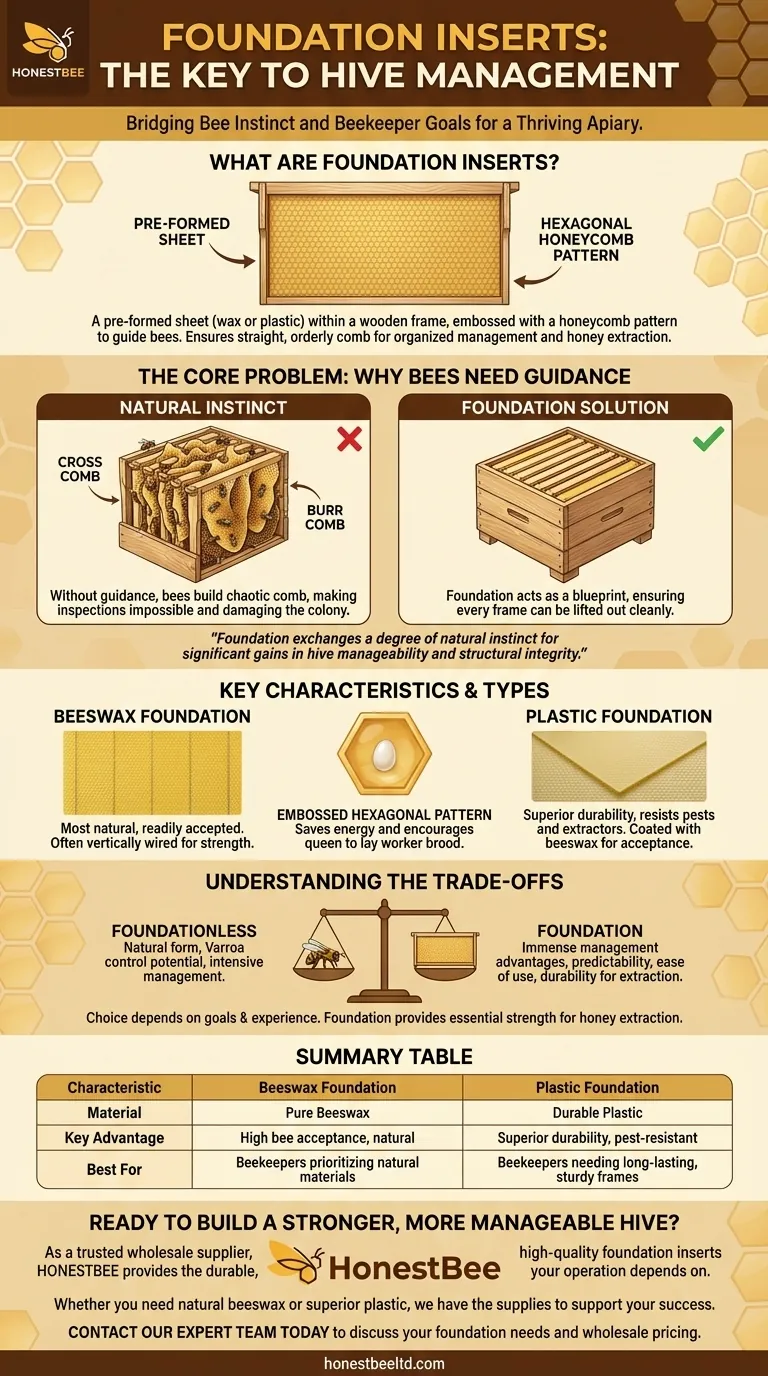In beekeeping, a foundation insert is a pre-formed sheet, typically made of wax or plastic, that is placed inside a wooden frame. It is embossed with a hexagonal honeycomb pattern to act as a guide for the bees. The primary purpose of foundation is to encourage bees to build straight, orderly comb within the frame, which is essential for organized hive management, inspections, and honey extraction.
The use of foundation is a fundamental trade-off in modern beekeeping: it exchanges a degree of the bees' natural building instinct for significant gains in hive manageability and structural integrity. It prevents the chaotic construction that can make a hive impossible to inspect.

The Core Problem: Why Bees Need Guidance
Left to their own devices, bees are master architects, but their goals do not always align with the beekeeper's. Foundation is the tool used to bridge that gap.
The Bee's Natural Instinct
Without any guidance, bees will build comb wherever they find empty space. This often results in "cross comb" or "burr comb," where they build comb connecting adjacent frames or attaching frames to the walls of the hive box.
The Beekeeper's Dilemma
This natural, chaotic construction makes hive management nearly impossible. Frames become fused together, and trying to remove one for inspection can rip the comb apart. This destroys brood, spills honey, and can severely stress or even kill the queen.
The Foundation Solution
A foundation insert acts as a blueprint. The hexagonal pattern gives the bees a clear starting point, encouraging them to build their wax cells neatly within the confines of the single, removable frame. This ensures every frame can be lifted out cleanly for inspection or harvesting.
Key Characteristics of Foundation
While the goal is always the same, foundation comes in different materials, each with distinct properties.
Beeswax Foundation
This is the most natural option. Made from pure beeswax, it is readily accepted by the colony. Bees can immediately begin drawing it out into full-depth cells. To increase its strength, beeswax foundation is often vertically wired.
Plastic Foundation
Plastic foundation offers superior durability. It will not warp in high heat and is highly resistant to damage from pests like wax moths or from the centrifugal force of honey extractors. To encourage acceptance, plastic foundation is almost always coated with a thin layer of beeswax.
The Embossed Hexagonal Pattern
The pre-molded hexagonal pattern serves two key functions. First, it saves the bees significant energy, as producing wax is a resource-intensive process. Second, the cells are sized specifically for worker brood, encouraging the queen to lay the eggs that will become the hive's workforce.
Understanding the Trade-offs
Using foundation is the standard practice, but it's important to understand the alternatives and compromises involved.
Foundation vs. Foundationless
Some beekeepers practice "foundationless" beekeeping, where they provide frames with only a small starter strip of wood or wax. This allows bees to build comb in whatever cell size they choose, which advocates argue is more natural and can help with Varroa mite control.
Management vs. Natural Form
The core trade-off is clear: foundation provides immense management advantages, predictability, and ease of use, especially for new beekeepers. Foundationless methods are closer to the bees' natural state but require more skill and frequent monitoring to prevent a hive from becoming an unmanageable mess of cross comb.
Durability During Extraction
One of the most significant practical advantages of foundation is strength. Natural comb without a central support is extremely fragile. Both wired wax and plastic foundation provide the rigidity needed to withstand honey extraction, where frames are spun at high speed to force the honey out.
Making the Right Choice for Your Hive
Your choice of foundation depends directly on your beekeeping goals and experience level.
- If your primary focus is ease of management and efficient honey harvesting: Opt for plastic or wired beeswax foundation for its predictability and exceptional durability.
- If you are a beginner beekeeper: Starting with a foundation is highly recommended to simplify hive inspections and prevent common structural problems that can frustrate a new beekeeper.
- If your primary focus is a more natural approach and you are an experienced beekeeper: You might explore foundationless methods, but be prepared for the intensive management it requires.
Ultimately, understanding the role of foundation empowers you to structure your hive for a successful partnership between you and your bees.
Summary Table:
| Characteristic | Beeswax Foundation | Plastic Foundation |
|---|---|---|
| Material | Pure Beeswax | Durable Plastic |
| Key Advantage | High bee acceptance, natural | Superior durability, pest-resistant |
| Best For | Beekeepers prioritizing natural materials | Beekeepers needing long-lasting, sturdy frames |
Ready to build a stronger, more manageable hive?
As a trusted wholesale supplier to commercial apiaries and distributors, HONESTBEE provides the durable, high-quality foundation inserts your operation depends on. Whether you need the natural acceptance of beeswax or the superior strength of plastic foundation, we have the supplies to support your success.
Contact our expert team today to discuss your foundation needs and wholesale pricing.
Visual Guide

Related Products
- Manual Beeswax Comb Foundation Machine Wax Foundation Mill Embossing Machine
- Professional Frame Preparation: The HONESTBEE Electric Wire Embedder
- Beeswax Foundation Sheets Beehive Foundation for Wholesale
- Food Grade Plastic bee Foundation for Bee Frames
- Manual Spur Wheel Wire Embedder for Foundation
People Also Ask
- What is a comb foundation mill? A Strategic Tool for Stronger, More Productive Hives
- What is the function of a beeswax foundation machine? Boost Hive Efficiency and Honey Production
- What is the importance of soaping the rollers during milling? Prevent Wax Adhesion & Equipment Downtime
- How should stuck wax on mill rollers be removed? A Gentle, Non-Damaging Cleaning Method
- How do honeybees use wax in their hives? The Key to Colony Survival and Structure



















